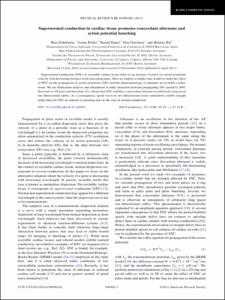Supernormal conduction in cardiac tissue promotes concordant alternans and action potential bunching

Visualitza/Obre
Cita com:
hdl:2117/12622
Tipus de documentArticle
Data publicació2011-04-04
Condicions d'accésAccés obert
Llevat que s'hi indiqui el contrari, els
continguts d'aquesta obra estan subjectes a la llicència de Creative Commons
:
Reconeixement-NoComercial-SenseObraDerivada 3.0 Espanya
Abstract
Supernormal conduction (SNC) in excitable cardiac tissue refers to an increase of pulse (or action potential)
velocity with decreasing distance to the preceding pulse. Here we employ a simple ionic model to study the effect
of SNC on the propagation of action potentials (APs) and the phenomenology of alternans in excitable cardiac
tissue. We use bifurcation analysis and simulations to study attraction between propagating APs caused by SNC
that leads to AP pairs and bunching. It is shown that SNC stabilizes concordant alternans in arbitrarily long paced
one-dimensional cables. As a consequence, spiral waves in two-dimensional tissue simulations exhibit straight
nodal lines for SNC in contrast to spiraling ones in the case of normal conduction
CitacióEchebarria, B. [et al.]. Supernormal conduction in cardiac tissue promotes concordant alternans and action potential bunching. "Physical review E: statistical, nonlinear, and soft matter physics", 04 Abril 2011, vol. 83, núm. 4, p. 1-4.
ISSN1539-3755
Versió de l'editorhttp://link.aps.org/doi/10.1103/PhysRevE.83.040902
| Fitxers | Descripció | Mida | Format | Visualitza |
|---|---|---|---|---|
| echevarria_Physical_E_2011.pdf | 539,4Kb | Visualitza/Obre |


